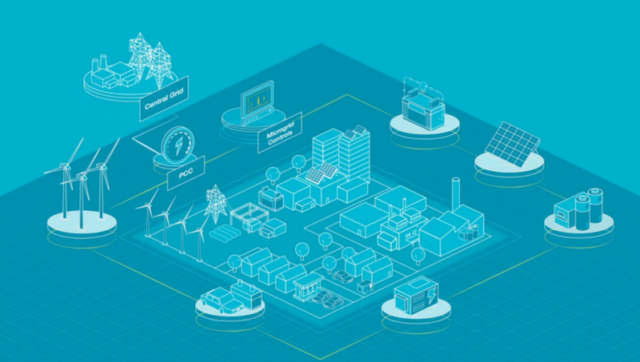>> Microgrids

*NYU
– Lights Stay on at New York University Thanks to Campus Microgrid
The lights and power stayed on at New York University (NYU) in 2011 even as Superstorm Sandy knocked out the utility grid and flooded lower Manhattan thanks to a campus microgrid. The system’s performance highlighted the benefits microgrids convey as New York moves forward with REV (Reforming the Energy Vision), the Cuomo administration’s sweeping energy policy reform, and clean distributed energy initiatives, such as the NY Prize community microgrid challenge, that put the state at the forefront of efforts to modernize and build a 21st century power grid.
“If you take a look at the blackouts that were in the New Jersey, New York, Connecticut realm of Superstorm Sandy, the only places that were up and operating were those places that had a microgrid,” says Hitachi Microgrid Solutions VP Steve Pullins in a blog report.
– Urban Future Lab Launches NYC Microgrid Contest
One microgrid and one smart cities project proposal will each earn its designer $25,000 from New York City’s Urban Future Lab, which is looking for projects that offer solutions to urban energy problems, according to a news report.
Winners will present their solutions to a panel of judges that include prospective investors, project partners and successful entrepreneurs. They will also join ACRE, a smart cities and cleantech ¨incubator¨ located at the NYU Urban Future Lab. Applications are due August 14.
“With the nation’s largest municipal markets in energy, transit, water and waste, New York City offers a living lab for companies to deploy their sustainable urban technologies,” explains Pat Sapinsley, managing director of cleantech initiatives at the NYU Tandon School of Engineering. “New York’s ambitious Reforming the Energy Vision (REV) initiative has created an unprecedented market opportunity for smart cities and cleantech startups to thrive.”
– ConEd to Build Solar-Storage Virtual Power Plant in NYC
New York utility Consolidate Edison (ConEd) is partnering with SunPower and Sunverge to build and operate a $15 million pilot Virtual Power Plant in New York City. Following through on Governor Andrew M. Cuomo’s strategic Reforming the Energy Vision (REV) plan, the project partners will install high-efficiency PV panels and lithium-ion battery storage systems in some 300 homes in the boroughs of Brooklyn and Queens, according to a news report.
ConEd’s aim in building what amounts to a utility neighborhood microgrid is assess the value, as well as revenue streams, solar PV and energy storage can deliver across a variety of factors: grid reliability and resiliency prominent among them. Looking ahead, the utility sees prospects of realizing benefits and new revenue streams in terms of transmission and distribution deferment, peak shaving, frequency regulation, capacity markets and wholesale markets.
According to the report, ConEd, which will own the battery storage systems initially, aims to gather 1.8 MW/4 MWh of capacity to serve as a “clean virtual power plant.”
ConEd initially taking ownership is a vehicle towards enabling creation of a broader-based market structure envisaged by REV in which third-party vendors/project developers will participate, as well as gauge consumers’ interest in purchasing on-site self-generation and storage capacity.
Homes are to be outfitted with 7 kW/9 kW rooftop PV systems and 6 kW/19.4 kWh energy storage system. In addition to being connected to the utility grid, the residential VPP component systems will provide homeowners with sufficient backup power to meet essential needs.
> International
– Microgrids and Wireless Telecoms Towers
Market research from international cellular telecoms industry and standards organization GSMA determined the telecoms tower industry can save as much as $13.8 billion per year by switching from diesel-fired electricity to green power, according to a blog post.
Importantly, the researchers also found that local communities can benefit from the emissions-free electricity the telecoms tower microgrids provide. People living in under-served, under-developed areas typically rely on charcoal or kerosene for lighting and cooking. These pose a variety of human and environmental threats, including smoke inhalation, fires, and deforestation.
GSMA estimates some 390,000 off-grid wireless telecoms towers will be erected by 2020. Another 790,000 will be located in areas that make grid access difficult and very costly. That would be a rise of 22% and 13%, respectively.
Governments can spur project development and the realization of these benefits by crafting and enacting clear, sustained policies that grant and protect the right of ESCOs (energy service companies) to sell electricity to their citizens at competitive prices.
¨Approximately 1.3 billion people lack access to electricity, and 1 billion more lack access to reliable electricity. In total, that’s approximately 31% of the world’s population. Over 80% of these people live in rural areas, making it expensive to extend the grid to them, says¨ CleanTechnica’s Zachary Shahan .
¨Surprisingly, many of these people already have mobile phones — approximately 6 billion of the world’s 7 billion people have access to mobile phones — and many more will be getting them in the coming months and years. The good news is that the explosion of the mobile phone market and the associated need for telecom towers throughout the world provide a good opportunity for much broader energy access.¨
>> Energy Storage

*Duke Home Depot Smart Home
– Retail Solar-Battery Storage a Big Part of Duke’s Smart Home Program
One of the nation’s largest utility and energy services groups, Duke Energy is moving forward with plans to launch a variety of battery-based energy storage projects as part of its Smart Home program.
Duke is showcasing and experimenting with prospective technologies and system configurations in the Home Depot Smart Home, a live-in research laboratory operated by the Pratt School of Engineering, management highlights in a news report. Among the current slate of projects on tap this year is creating an electric bike and a solar bench, explained Duke Smart Home VP Harvey Shi.
“The design behind the bench project would be to incorporate a large solar panel into the existing roof structure of a bench, reinforcing it if necessary,” says Shi. “We would then add a weatherproof housing under the desk, which contains batteries for nighttime use.”
In addition, rain-proof LED lighting panels will be installed on the underside of the roof, and USB chargers for mobile phones and tablets will be included.
“I think it is kind of good that our projects are all revolving around the same theme because we can really concentrate on it and spend our time learning about it,” adds Smart Home president Lauren Shum. “It also means that people who are working on one project will have a lot of useful information to share with people working on other projects.”
> International
– Electrovaya to Supply More than eur199 million of Residential Battery Storage Modules
The Canadian lithium-ion battery storage systems manufacturer announced the signing of a Letter of Intent (LoI) with an unnamed “major Original Equipment Manufacturer” for delivery of its lithium-ion battery modules, according to a news report.
Electrovaya sees bright prospects for residential energy storage systems given rapid growth of residential solar power systems and growing demand for electric vehicles (EVs).
Valued at more than eur199 million, the deal is to extend over three years. Initial delivery is slated for Q4 2016 or early Q1 2017.
Electrovaya’s lithium-ion battery modules come with integrated cells and battery management systems (iBMS), and due to the modules’ focus on safety and cycle life performance, they are well suited to residential energy storage.
>> Community Solar

– Maryland PSC Approves Final Community Solar Regulations
State regulatory approval leaves Maryland poised to join 10 other states with community solar programs. The Maryland Public Service Commission (PSC)’s approval green-lights a three-year pilot community solar program.
The community solar pilot program has been geared specifically towards low- and moderate-income households. Details are expected to be released to the public in coming weeks and become final in mid-July, according to a news report.
The program plan calls for about 30 percent (60 MW) of the state’s community 200 MW solar cap be set aside for low- to moderate-income residents.
The plan also focuses on spurring brownfield community solar project development, parking lots, and industrial areas. That would turn tainted, unused, and ugly areas of land that also pose threats to health and safety into sources of community self-sufficiency and pride, he news report states.
– Southern Minnesota County Enters into 25-Year Community Solar Gardens Agreement
Southern Minnesota’s Rice County Parks and Facilities has entered into a 25-year community solar gardens development agreement with Geronimo Energy. The Rice County Board of Commissioners approved the agreement this past Tuesday following presentations by representatives of developers Geronimo Energy and Solar Stone, according to a news report.
Community solar garden project planners expect energy cost savings of around $18,000 per year and $442,964 over the life of the agreement, which is to see PV-produced electricity sent over a utility grid to government services buildings including the local courthouse, community corrections facility, jail annex, and a highway shop.
Utility Xcel Energy will manage owner-subscriber account administration, including crediting each subscriber’s utility bill for electricity received from the community solar gardens.
A Rice County official said the county will subscribe for community solar garden shares equivalent to 1.9 million kWh of energy from six community solar gardens in adjacent counties, which will be built adjacent to Xcel substations.
